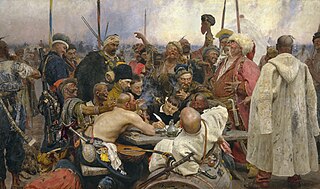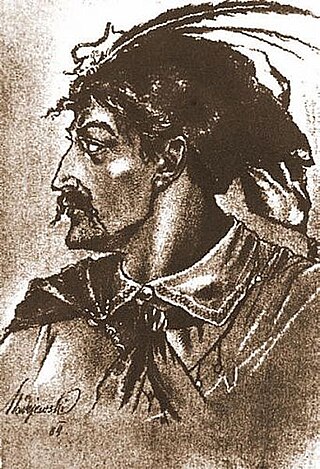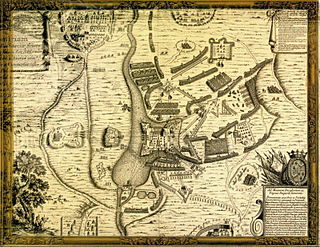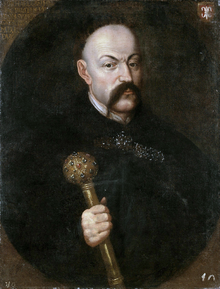
Bohdan Zynoviy Mykhailovych Khmelnytsky was a Ruthenian nobleman and military commander of Zaporozhian Cossacks as Hetman of the Zaporozhian Host, which was then under the suzerainty of the Polish–Lithuanian Commonwealth. He led an uprising against the Commonwealth and its magnates (1648–1654) that resulted in the creation of an independent Cossack state in Ukraine. In 1654, he concluded the Treaty of Pereiaslav with the Russian Tsar and allied the Cossack Hetmanate with Tsardom of Russia, thus placing central Ukraine under Russian protection. During the uprising the Cossacks he led a massacre of thousands of Poles and Jews during 1648 and 1649, making it one of the most traumatic events in the history of the Jews and antisemitism in Ukraine.

The Pereiaslav Agreement or Pereyaslav Agreement was an official meeting that convened for a ceremonial pledge of allegiance by Cossacks to the Russian tsar, then Alexis, in the town of Pereiaslav in central Ukraine, in January 1654. The ceremony took place concurrently with ongoing negotiations that started on the initiative of Hetman Bohdan Khmelnytsky to address the issue of the Cossack Hetmanate with the ongoing Khmelnytsky Uprising against the Polish–Lithuanian Commonwealth and which concluded the Treaty of Pereiaslav. The treaty itself was finalized in Moscow in April 1654.

The Truce of Andrusovo established a thirteen-and-a-half year truce, signed on 9 February [O.S. 30 January] 1667 between the Tsardom of Russia and the Polish–Lithuanian Commonwealth, which had fought the Russo-Polish War since 1654 over the territories of modern-day Ukraine and Belarus.

The Treaty of Hadiach was a treaty signed on 16 September 1658 in Hadiach between representatives of the Polish–Lithuanian Commonwealth and Zaporozhian Cossacks.

Ivan Bohun was a Zaporozhian Cossack colonel. Close associate and friend of Bohdan Khmelnytsky, he opposed both the pacts with Polish–Lithuanian Commonwealth and with Tsardom of Russia.

Yurii Khmelnytsky, younger son of the famous Ukrainian Hetman Bohdan Khmelnytsky and brother of Tymofiy Khmelnytsky, was a Zaporozhian Cossack political and military leader. Although he spent half of his adult life as a monk and archimandrite, he also was Hetman of Ukraine on several occasions — in 1659-1660 and 1678–1681 and starost of Hadiach, becoming one of the most well-known Ukrainian politicians of the "Ruin" period for the Cossack Hetmanate.

Prince Aleksey Nikitich Trubetskoy was the last voivode of the Trubetskoy family and a diplomat who was active in negotiations with Poland and Sweden in 1647 and with the ambassadors of Bohdan Khmelnytsky in 1654. He was the godfather of Peter I of Russia.

The Russo-Polish War of 1654–1667, also called the Thirteen Years' War, Muscovite War of 1654–1667 and the First Northern War, was a major conflict between the Tsardom of Russia and the Polish–Lithuanian Commonwealth. Between 1655 and 1660, the Swedish invasion was also fought in the Polish–Lithuanian Commonwealth and so the period became known in Poland as "The Deluge".
The Ruin is a historical term introduced by the Cossack chronicle writer Samiilo Velychko (1670–1728) for the political situation in Ukrainian history during the second half of the 17th century.

The Battle of Konotop or Battle of Sosnivka was fought between a coalition led by the Hetman of Zaporizhian Cossacks Ivan Vyhovsky and cavalry units of the Russian Tsardom under the command of Semyon Pozharsky and Semyon Lvov, supported by Cossacks of Ivan Bezpaly, on 29 June 1659, near the town of Konotop, Ukraine, during the Russo-Polish War (1654–1667). Vyhovsky's coalition defeated the Russians and their allies and forced the main Russian army to interrupt the siege of Konotop. However, the result of the battle only intensified political tensions in Ukraine and led to Vyhovsky's removal from power several months later.

The Wild Fields is a historical term used in the Polish–Lithuanian documents of the 16th to 18th centuries to refer to the Pontic steppe in the territory of present-day Eastern and Southern Ukraine and Western Russia, north of the Black Sea and Azov Sea. It was the traditional name for the Black Sea steppes in the 16th and 17th centuries. In a narrow sense, it is the historical name for the demarcated and sparsely populated Black Sea steppes between the middle and lower reaches of the Dniester in the west, the lower reaches of the Don and the Siverskyi Donets in the east, from the left tributary of the Dnipro — Samara, and the upper reaches of the Southern Bug — Syniukha and Ingul in the north, to the Black and Azov Seas and Crimea in the south.
The Battle of Lyubar or battle of Lubar took place on 14–27 September 1660 near Lyubar, during the Russo-Polish War (1654–1667), between the forces of the Polish–Lithuanian Commonwealth and Tsardom of Russia. It was the first battle of the 1660 campaign in the south. It ended with a Polish victory. The Russian army retreated and was subsequently destroyed during the battle of Chudniv.
The Battle of Okhmativ or battle of Ochmatów took place around 19 January - 22 January 1655 during the Russo-Polish War (1654–67) between the armies of the Polish–Lithuanian Commonwealth and the Crimean Khanate on the one hand and of the Russian Tsardom and the Cossacks on the other.

The Battle of Szkłów or battle of Shkloŭ or battle of Shklov on August 12, 1654 was one of the first battles of the Russo-Polish War (1654–67); it ended with a indecisive, however, by other sources. A small Polish–Lithuanian force of about 6,000–7,000 under Great Lithuanian Hetman Janusz Radziwiłł surprised a numerically superior Russian force under knyaz Yakov Cherkassky near Shklow. The battle took place during a solar eclipse. The Russian forces, due to their surprise, were engaged by the Poles unprepared and in smaller portions, which were defeated in turn. Eventually the Poles forced the entire Russian army to retreat; the losses are estimated at 700 for the Poles and 7,000 for the Russians.

The Battle of Shepeleviche (Szepielewicze) or Battle of Ciecierzyn on 24 August 1654 was one of the first battles of the Russo-Polish War (1654–67). It ended with a Russian victory.

Battle of the Basya (Basia) River took place between 24 September and 10 October 1660, between the forces of the Polish–Lithuanian Commonwealth and the Tsardom of Russia, allied with the Cossacks and Tatars, near Basya River in the modern Mahilyow Voblast. Russian army of about 15,000 under Yuri Dolgorukov met the Polish force of about 24,000 under Stefan Czarniecki.

The Principality of Smolensk was a Kievan Rus' lordship from the 11th to the 16th century. Until 1127, when it passed to Rostislav Mstislavich, the principality was part of the land of Kiev. The principality gradually came under Lithuanian influence and was incorporated into the Grand Duchy of Lithuania in 1404. The principality was reorganized into the Smolensk Voivodeship in 1508. The Principality of Moscow controlled the city from 1514 to 1611, then it was recaptured by the Polish–Lithuanian Commonwealth. Tsardom of Russia recaptured the city in 1654.

The Unknown War is a military history book written by Hienadz Sahanovich. It describes the events of the war between Tsardom of Russia and the Polish–Lithuanian Commonwealth in 1654-67. The war has become known as a part of the "Deluge", a series of military conflicts that overwhelmed the Polish–Lithuanian Commonwealth in the middle of the 17th century which included the Khmelnytsky Uprising, the Swedish invasion, and the Russian invasion among others.
Battle of Myadel was a battle of the Russo-Polish War (1654–67) which took place on February 8, 1659 near the Belarusian town of Myadzel. The Russian army of Novgorod led by Ivan Khovansky defeated the Polish–Lithuanians led by Mikołaj Judycki and Władysław Wołłowicz. As a result, the Polish-Lithuanian army retreated to the safety of the walls of Lyakhovichi.
Treaty of Chudnov, Treaty of Cudnów or Treaty of Slobodishche was a treaty between the Polish–Lithuanian Commonwealth and the Cossack Hetmanate, signed in Chudniv on 17 October 1660 during the Khmelnytsky Uprising. It restored most of the provisions of the Treaty of Hadiach, except for the elevation of Ruthenia to the status equal of the Poland and Lithuania. It invalidated the Pereiaslav Articles, which were often considered unfavorable for Ukraine, severed the union with the Tsardom of Russia and restored Ukraine's state ties with the Polish–Lithuanian Commonwealth. Although the Ukrainian government insisted on the full restoration of the Treaty of Hadiach of 1658, the side of the Polish–Lithuanian Commonwealth, represented by Stanisław Potocki and Jerzy Sebastian Lubomirski, did not agree to the restitution of the Grand Duchy of Ruthenia, leaving other points of the Treaty of Hadiach in force.














